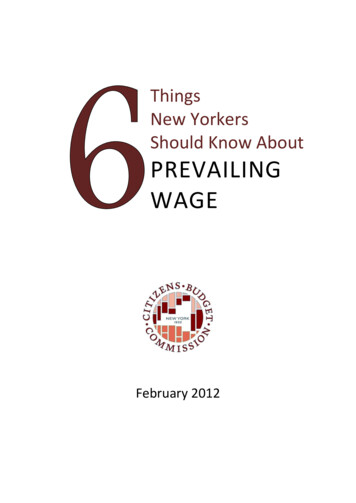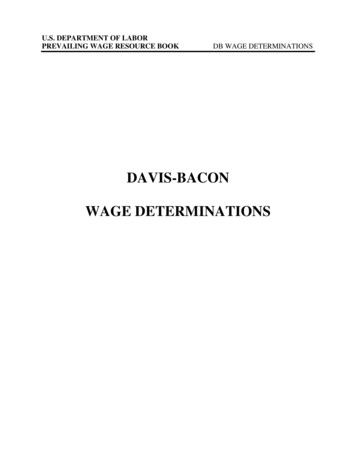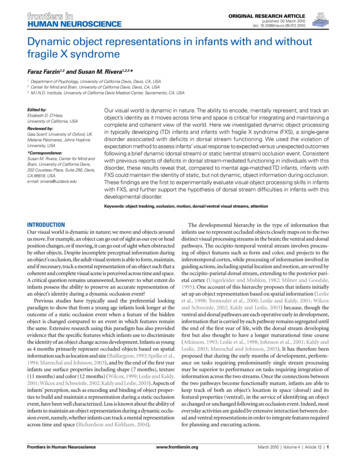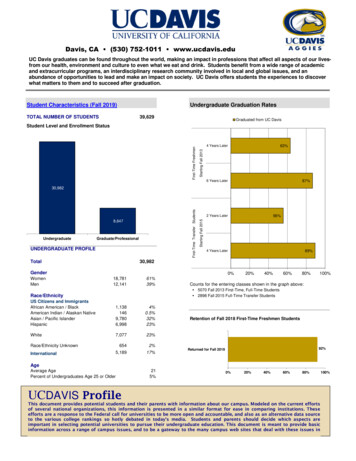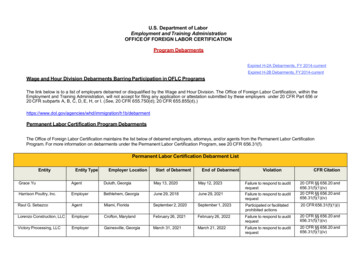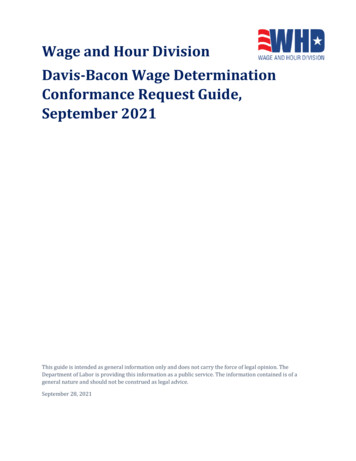
Transcription
Wage and Hour DivisionDavis-Bacon Wage DeterminationConformance Request Guide,September 2021This guide is intended as general information only and does not carry the force of legal opinion. TheDepartment of Labor is providing this information as a public service. The information contained is of ageneral nature and should not be construed as legal advice.September 28, 2021
Wage and Hour DivisionDavis-Bacon Wage DeterminationConformance Request Guide,September 2021What are the Davis-Bacon and Related Acts?The Davis-Bacon and Related Acts (DBRA) require payment of local prevailing wages toconstruction workers performing work on federally funded construction projects. The DavisBacon Act (DBA) applies to each federal government or District of Columbia contract in excessof 2,000 for the construction, alteration, or repair (including painting and decorating) of publicbuildings or public works and requires that contractors and subcontractors pay their laborersand mechanics employed under such contracts no less than the locally prevailing wages andfringe benefits for corresponding work on similar projects in the area. The DBA’s prevailingwage provisions also apply to “Related Acts,” under which federal agencies assist constructionprojects through grants, loans, loan guarantees, and insurance. Examples of Related Actsinclude the Federal-Aid Highway Acts, the Housing and Community Development Act of 1974,and the Federal Water Pollution Control Act. The Wage and Hour Division (WHD) of the U.S.Department of Labor administers the DBRA.What is a Davis-Bacon prevailing wage?The Davis-Bacon prevailing wage is the combination of the basic hourly wage rate and anyfringe benefits rate listed for a specific classification of workers in the applicable Davis-Baconwage determination. The contractor’s prevailing wage obligation may be met by either payingeach laborer and mechanic the applicable prevailing wage entirely as cash wages or by acombination of cash wages and employer-provided bona fide fringe benefits.What is a wage determination?A wage determination is the list of basic hourly wage rates and fringe benefit rates for eachclassification of laborers and mechanics (“labor classification”) in a predetermined geographicarea for a particular type of construction. WHD conducts surveys of local wages to determinethe prevailing wage rates that are included in wage determinations.There are two types of wage determinations: general determinations and projectdeterminations.Wage and Hour Divi sion Branch of Construction Wage Det erminations1
General Wage DeterminationsA general wage determination reflects wage rates determined by WHD to be prevailing in aspecific geographic area for a certain type of construction and does not expire.General Davis-Bacon wage determinations are published online at www.sam.gov and areavailable for contracting agencies to incorporate into covered contracts and for contractors topost at the job site of covered projects.Project Wage DeterminationsA project wage determination is issued at the request of a contracting agency and is applicableto the named project only. These typically expire 180 calendar days from the date of issuance.Project Wage Determinations must be requested by the agency by submitting SF-308. Whileuncommon, if you believe you may need a project wage determination, please consult withWHD.What are the types of construction represented in wage determinations?Wage determinations are issued for four types of construction categories: building, residentialhighway, and heavy.Building construction includes the construction, alteration, or repair of sheltered enclosureswith walk-in access for the purpose of housing persons, machinery, equipment, or supplies andthe associated installation of utilities and equipment, as well as incidental grading and paving .Residential construction includes the construction, alteration, or repair of single family houses,townhouses, and apartment buildings of no more than four stories in height and all incidentalwork, such as site work, parking areas, utilities, streets, and sidewalks.Highway construction includes the construction, alteration, or repair of roads, streets, highways,runways, parking areas and most other paving work not incidental to building, residential, orheavy construction.Heavy construction includes projects that cannot be classified as Building, Residential, orHighway. Heavy construction is often further distinguished on the basis of the characteristic ofparticular projects, such as dredging, water and sewer lines, dams, major bridges, and floodcontrol projects.For more information, please refer to All Agency Memoranda (AAM) 130 and 131.How do I read a wage determination?An understanding of the wage determination helps contracting officers and contractors identifyand understand the wages and benefits required to be paid to laborers and mechanics on thecontract. The following is a brief guide for reading a wage determination:Wage and Hour Divi sion Branch of Construction Wage Det erminations2
1. Identify the geographic area. Typically, the state and the county or counties covered by thewage determination are noted at the top of the wage determination. It is critical to use thecorrect wage determination for the geographic area where the project will be performed.2. Identify the construction type. The construction type will be listed at the top of the wagedetermination (Building, Residential, Highway or Heavy).3. Identify the proper labor classification(s). Labor classifications, not individual tasks, are listedon wage determinations. It is, therefore, vital to understand the scope of the project andthe labor classifications that are necessary for the work to be performed.4. Understand the labor classification identifier. The labor classification identifier providesinformation about how the prevailing wage was calculated:Those that begin with “SU” denote a prevailing wage that is not based exclusively on unionwage rates.Example: For identifier SULA2018-007 05/13/2018SU the prevailing wage rate is based on a weighted average of survey dataLA the state, in this example, Louisiana2018 the year of the survey007 internal number used for producing the wage determination05/13/2018 the survey completion date for the labor classifications and rates under thatidentifierThose that begin with “UAVG” indicate that while no single union rate prevailed for thoselabor classifications, the average is based upon only union wage data.Example: For identifier UAVG-OH-0010 08/29/2014UAVG the prevailing wage rate is a weighted union average rateOH the state, in this example, Ohio0010 internal number used for producing the wage determination08/29/2014 the survey completion date for the labor classifications and rates under thatidentifierThose that begin with anything other than “SU” or “UAVG” indicate that a CBA-based rateprevailed.Example: For identifier PLUM0198-005 07/01/2020PLUM the prevailing wage rate is based on a Plumbers union collective bargainingagreement.0198 the local union (or district council where applicable)005 internal number used in producing the wage determination07/01/2020 the effective date of the most current negotiated (CBA) rateWage and Hour Divi sion Branch of Construction Wage Det erminations3
5. Understand the labor classification as well as wage rates and fringe benefits. On a wagedetermination, several labor classifications may be listed under a labor classificationidentifier indicating that these separate labor classifications are based on the same surveyor CBA. Each labor classification has a wage rate and employer-provided bona fide fringebenefits rate listed with it on the wage determination.Example:BRMA0003-004 02/01/2021RatesTILE FINISHER. 42.57TILE SETTER. 54.69Fringes32.0035.796. Note other relevant information including the application and effect of executive ordersrelated to hourly minimum wages. Some wage determinations may include requirementsbased on Executive Orders. For example, Executive Order 13658 requires a minimum wagefor workers on covered federal contracts. An Executive Order may be referenced at the topof the determination or after the labor classifications.What is a conformance?In limited circumstances, when there is no appropriate labor classification on the applicablegeneral wage determination, WHD may add or “conform” a new class of laborer or mechanicand a wage rate to a published wage determination for a specific contract. A conformance mayonly be granted when certain criteria are met.First, a conformance is granted by WHD only when the type of work needed for a project isnot performed by a labor classification already listed on the applicable wage determination.Second, the purpose of the conformance process is not to create new constructionclassifications but to determine the prevailing wage for standard construction classificationswhen they are missing from the applicable wage determination, often as the result of lowparticipation in a Davis-Bacon wage survey. Therefore, the conformed labor classification mustbe one that is actually used in the area by the construction industry.Finally, if WHD grants a conformance, the wage rate selected will be one that bears a“reasonable relationship” to the existing wage rates on the applicable wage determination. Asexplained in AAM 213, this generally involves a comparison of the proposed wage rate,including any fringe benefits, to the wage rates for similar labor classifications on the wagedetermination.How do I know if I need a conformance?Understanding the wage determination is key to determining whether you need aconformance. Compare labor classifications on the wage determination with the anticipatedwork to be performed. Conversation between the contracting agency, contractors and WHDwill help identify any potential missing labor classifications. Typically, the labor classificationsWage and Hour Divi sion Branch of Construction Wage Det erminations4
listed on the wage determination include the work being performed on a Davis-Bacon coveredcontract.The scope of work performed by a labor classification will depend on local area practice.Therefore, if it is unclear whether a labor classification on the wage determination performs thework in question, it may be helpful to consult WHD and/or local construction industrystakeholders.When the type of worker that performs the work needed on your project is listed on thegeneral wage determination, you should not request a conformance.When do I need to request a conformance?Only after reviewing the wage determination and identifying a missing labor classificationneeded to perform the work on the project should you seek a conformance. Please note,wanting to pay a lower wage rate rather than the prevailing wage listed is not grounds for aconformance request. Laborers and mechanics are required to be paid the prevailing wage forthe labor classification of work actually performed.The following examples discuss whether a conformance is needed in common scenariosinvolving the types of work performed on federal contracts. Please note that, in someinstances, the scope of work performed by these labor classifications may differ based on localpractice, and a different conformance outcome may be warranted. When determining whethera conformance is required, it is important to review the applicable wage determinations and, ifneeded, consult WHD and/or local stakeholders.Examples:Broadband: A large infrastructure contract has been funded to promote rural broadbandand Davis-Bacon applies due to the funding source.Q: Do you need to seek a conformance?A: No, “broadband” is not a labor classification. Typically, a broadband infrastructureproject will include the labor classifications for power equipment operators, generallaborers, and electricians; if the necessary labor classifications are listed on the wagedetermination, you do not need to seek a conformance.Weatherization Carpenter: A large infrastructure contract has been funded to provideweatherization services to residential homes and Davis-Bacon prevailing wage rates applydue to the funding source. Such work is typically performed by carpenters and the wagedetermination contains a carpenter classification.Q: Do you need to seek a conformance because the work is called weatherization?A: No, the required work is typically performed by carpenters, a labor classification includedon the wage determination.Wage and Hour Divi sion Branch of Construction Wage Det erminations5
Window Seal Worker: The project requires that windows be sealed to create a soundbarrier. The wage determination lists a glazier classification.Q: Do you need to seek a conformance?A: No, sealing windows is incidental to window repair and window installation, which iscovered by the glazier classification.Mechanical Insulator: The project requires that the mechanical system of a large industrialfacility be insulated to prevent heat damage. The wage determination lists the Heat andFrost Insulator classification.Q: Do you need to seek a conformance?A: No, the work to be performed typically falls under the Heat and Frost Insulatorclassification listed on the wage determination.Bricklayer: The project requires a decorative masonry wall. The wage determination includesa bricklayer classification with a prevailing wage rate based on a union collective bargainingagreement. The contractor is not party to the union agreement.Q: Do you need to seek a conformance?A: No, the prevailing rate for the needed labor classification that is listed on the wagedetermination applies regardless of the union/non-union affiliation of the contractor.Low-voltage Wiring: The project includes installing audio and video cables throughout abuilding. The wage determination includes an electrician classification with a unionprevailing wage, but does not include a low-voltage electrician classification. The localelectrical union identified on the wage determination does not perform low-voltageelectrical work.Q: Do you need to seek a conformance?A: Yes, the work at issue does not fall within a published labor classification on the wagedetermination.Boilermaker: An industrial project includes the retrofitting of a coal fired generator to burnclean fuel. The wage determination does not include a boilermaker classification and thiswork is not within the scope of work of any other labor classification on the wagedetermination.Q: Do you need to seek a conformance?A: Yes, the work at issue does not fall within a published labor classification on the wagedetermination.Wage and Hour Divi sion Branch of Construction Wage Det erminations6
How do I request a conformance?If you have identified that a conformance is likely required, WHD recommends the followingsteps for contracting agencies:1. Work with the contractors and other affected parties to help develop the conformancerequest.Provide the conformance request form (SF-1444 or similar) to the contractor. Instructionson how to complete the form are printed on the form. The SF-1444 can be downloadedfrom www.sam.gov. (See Resources below)As part of the conformance request, you will need to provide information about the work tobe performed on the project, the requested labor classification, the duties to be performedby that labor classification and a recommended wage rate. It may be helpful to consider theinput of affected parties, including the prime contractor, subcontractor, unionrepresentatives, and workers.2. Ensure the request meets the conformance criteria to ensure that: The type of work to be performed is not performed by a labor classification alreadylisted on the applicable wage determination; The requested labor classification is one actually used in the area by the constructionindustry; and The recommended wage rate bears a “reasonable relationship” to other wage rates inthe wage determination, specifically those from the same category of classifications andsector of industry as the proposed classification. (See AAM 213 for further guidance onthe “reasonable relationship” analysis).3. Submit conformance request for WHD review and approval, including the following: The applicable wage determination;The completed SF-1444 (or similar), including all required signatures;A written detailed description of the work to be performed by the requestedclassification; andAny related documentation and agency recommendation.Email the completed SF-1444 (or similar) and supporting materials to:WHD-CBACONFORMANCE INCOMING@dol.gov .What happens after I submit the conformance request to the Wage andHour Division?Once you have submitted your conformance request, WHD staff conducts a thorough review ofthe requested conformance before final approval or denial. Generally, the process includes thefollowing steps:Wage and Hour Divi sion Branch of Construction Wage Det erminations7
1. The conformance request is received by WHD and assigned to a WHD analyst.2. The WHD analyst works with the requesting contracting officer to ensure that the requestincludes all necessary information.3. The WHD analyst reviews the conformance request and: Confirms that the wage determination does not include the requested laborclassification;Researches the local area practice, if necessary, to verify the appropriate laborclassification; andDetermines whether the proposed wage rate bears a “reasonable relationship” to theexisting wage rates in the applicable wage determination.4. The WHD supervisor reviews and finalizes a written response to the conformance request.5. The Contracting Officer that submitted the request is sent the written response approving ordenying the conformance.Resources:GeneralGeneral DBRA information: cts/construction cts/construction/faq.Forms: Download Form SF-1444: Request for Authorization of Additional Classification andRate. Use this form to request a conformance from WHD.Download Form SF-308: Request for Wage Determination and Response to Request.Use this form to request a project wage determination.Applicable Regulations: 29 C.F.R. § 5.5(a)(1)(ii): Provides regulatory criteria for a conformance and sets forthconformance procedures.Guidance: AAM 130 and 131: Provide guidance on the categories of construction for which WHDissues WDs.AAM 213: Provides guidance on the application of the DBRA requirement that wagerates for additional or “conformed” classifications bear a "reasonable relationship" tothe wage rates in that wage determination.Wage and Hour Divi sion Branch of Construction Wage Det erminations8
Contact WHD:WHD is here to help ensure that contracting agencies and contractors understand how tocomply with the Davis-Bacon Act requirements and to ensure that federal construction dollarsare used to pay laborers and mechanics the wages they are entitled to under the law. For specific questions related to wage determinations or conformances, please contactRhonTia S. Thomas-Johnson, Chief, Branch of Construction Wage Determinations, atThomas.RhonTia@dol.gov, orEmail us at WHD-CBAConformance Incoming@dol.gov.Wage and Hour Divi sion Branch of Construction Wage Det erminations9
OH the state, in this example, Ohio 0010 internal number used for producing the wage determination 08/29/2014 the survey completion date for the labor classifications and rates under that identifier Those that begin with anything other than "SU" or "UAVG" indicate that a A-based rate prevailed.
